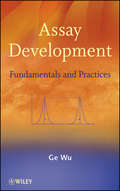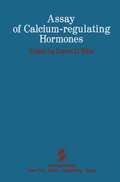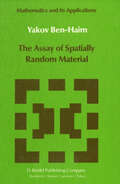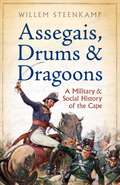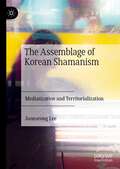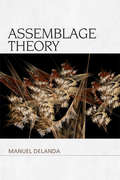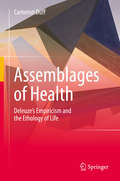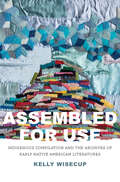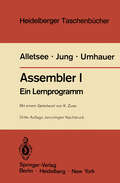- Table View
- List View
Assay Development: Fundamentals and Practices
by Ge WuEssential principles and practice of assay development The first comprehensive, integrated treatment of the subject, Assay Development: Fundamentals and Practices covers the essentials and techniques involved in carrying out an assay project in either a biotechnology/drug discovery setting or a platform setting. Rather than attempting comprehensive coverage of all assay development technologies, the book introduces the most widely used assay development technologies and illustrates the art of assay development through a few commonly encountered biological targets in assay development (e.g., proteases, kinases, ion channels, and G protein-coupled receptors). Just enough biological background for these biological targets is provided so that the reader can follow the logics of assay development. Chapters discuss: The basics of assay development, including foundational concepts and applications Commonly used instrumental methods for both biochemical assays and cell-based assays Assay strategies for protein binding and enzymatic activity Cell-based assays High-throughput screening An in-depth study of the now popular Caliper's off-chip kinase assay provides an instructive, real-world example of the assay development process.
Assay of Calcium-regulating Hormones
by Daniel D. BikleThe ability to measure accurately the hormones regulating calcium homeosta sis is the fundamental first step toward understanding the roles these hormones play in health and disease. Techniques for such measurements have only been available for the past 10 years or so and remain in a state of rapid development. Sensitive parathyroid hormone (PTH) radioimmunoassays appeared in the early 1970s, and with them came a whole new appreciation for the prevalence and implications of hyperparathyroidism, primary or secondary, in the popu lation. The calcitonin (CT) radioimmunoassay came later and achieved rapid success in the. diagnosis of a previously poorly understood cancer, medullary carcinoma of the thyroid, frequently associated with the familial multiple endo crine neoplasia type 2 syndromes (a and b). As the sensitivity of the calcitonin radioimmunoassay has improved, our understanding of the role of calcitonin in normal physiological processes has increased. The knowledge that vitamin D must be metabolized to produce its biologic effects is only 15 years old. This has had profound implications in our understanding of a variety of metabolic bone, kidney, and gastrointestinal diseases. Assays to measure the major cir culating form of vitamin D, 25-hydroxyvitamin D, were described 10 years ago. Assays for the other metabolites, in particular, 1,25-dihydroxyvitamin D, were described even more recently. As of today, we know of many vitamin D metabolites and have developed the techniques to measure most of them; how ever, many questions remain concerning their physiological role.
The Assay of Spatially Random Material (Mathematics and Its Applications #20)
by Yakov Ben-HaimApproach your problems from the right end It isn't that they can't see the solution. It is and begin with the answers. Then one day, that they can't see the problem. perhaps you will find the final question. G. K. Chesterton. The Scandal of Father 'The Hermit Clad in Crane Feathers' in R. Brown The point of a Pin'. van Gulik's The Chinese Maze Murders. Growing specialization and diversification have brought a host of monographs and textbooks on increasingly specialized topics. However, the "tree" of knowledge of mathematics and related fields does not grow only by putting forth new branches. It also happens, quite often in fact, that branches which were thought to be completely disparate are suddenly seen to be related. Further, the kind and level of sophistication of mathematics applied in various sciences has changed drastically in recent years: measure theory is used (non trivially) in regional and theoretical economics; algebraic geometry interacts with physics; the Minkowsky lemma, coding theory and the structure of water meet one another in packing and covering theory; quantum fields, crystal defects and mathematical programming profit from homotopy theory; Lie algebras are relevant to filtering; and prediction and electrical engineering can use Stein spaces. And in addition to this there are such new emerging subdisciplines as "experimental mathematics", "CFD", "completely integrable systems", "chaos, synergetics and large-scale order", which are almost impossible to fit into the existing classification schemes. They draw upon widely different sections of mathematics.
Assegais, Drums & Dragoons: A Military And Social History Of The Cape
by Willem SteenkampWhat motivated a small multiracial force of Cape-born soldiers - whites, coloureds and Malays - to put up such stiff resistance at the Battle of Blaauwberg in 1806, in spite of odds so overwhelming that even some long-serving professional soldiers broke rank and ran? This was the intriguing question that launched author Willem Steenkamp's research. It was an investigation which eventually took him back to 150 years before Jan van Riebeeck landed at the Cape in 1652, and involved examining the social as well as the military history of the Cape. What Steenkamp discovered differs from what most South Africans think about that period, and he corrects a number of serious misconceptions not only about the soldiers of 1510-1806 but about the social and political development of the Cape. For students of the Napoleonic Wars, the book provides new information about a forgotten aspect of that conflict; for the ordinary reader here is a story no-one has ever told before in its entirety. Assegais, Drums and Dragoons: A Military and Social History of the Cape is a well-researched and fascinating account that now illuminates a previously lightless corner of South African military history Descended from a 1690s-era solider, Willem Steenkamp is a writer, journalist and specialist tour guide who has also been a solider, a security advisor and a director of military tattoos and other spectacles, among several other things. Since childhood he has been absorbing the Cape's history from family stories (one of his ancestors was a hero of the Battle of Blaauwberg) and voluminous reading. And yes, he actually has fired flintlock muskets and muzzle-loading cannon. Willem lives in Cape Town.
Assekuranz, Ökologie und Risiko: Versicherungen als Mitgestalter des ökologischen Generationenvertrages (DUV Wirtschaftswissenschaft)
by Reiner WiedenlübbertDer Autor untersucht das Spannungsdreieck von Assekuranz, Ökologie und Risiko und kommt zu dem Ergebnis, dass die Versicherungswirtschaft den "ökologischen Generationenvertrag" aktiv mitgestalten sollte.
Assemblage, Enactment, and Agency: Educational policy perspectives
by Melody Viczko Augusto RiverosAssemblage, Enactment, and Agency offers an exploration of the emerging shift in policy research towards the notion of policy enactment, namely, the creative recontextualization and translation of policy ideas into social realities by policy actors in education. Bringing together recent work on the intersections between assemblages, enactments, and agencies in educational policy analysis, the authors call attention to issues of subjectivity, practice, power, and relationality as they offer critical perspectives that challenge linear/instrumentalist views of policy processes. In doing so, they not only interrogate conventional understandings of policy design, implementation, and evaluation, they also recognize the role of agency, interpretation, sense-making, translation, embodiment, and meaning throughout policy processes. They also explore the contested nature of policy, situating educational policies as sites of conflict and negotiation between actors, highlighting the uncertainty, fragility and instability of policy work. By offering a non-linear and heterogeneous account of education policy, the collection furthers contemporary conversations on the nature and goals of education reform. This book was originally published as a special issue of Discourse: Studies in the Cultural Politics of Education.
Assemblage, Enactment, and Agency: Educational policy perspectives
by Melody Viczko Augusto RiverosAssemblage, Enactment, and Agency offers an exploration of the emerging shift in policy research towards the notion of policy enactment, namely, the creative recontextualization and translation of policy ideas into social realities by policy actors in education. Bringing together recent work on the intersections between assemblages, enactments, and agencies in educational policy analysis, the authors call attention to issues of subjectivity, practice, power, and relationality as they offer critical perspectives that challenge linear/instrumentalist views of policy processes. In doing so, they not only interrogate conventional understandings of policy design, implementation, and evaluation, they also recognize the role of agency, interpretation, sense-making, translation, embodiment, and meaning throughout policy processes. They also explore the contested nature of policy, situating educational policies as sites of conflict and negotiation between actors, highlighting the uncertainty, fragility and instability of policy work. By offering a non-linear and heterogeneous account of education policy, the collection furthers contemporary conversations on the nature and goals of education reform. This book was originally published as a special issue of Discourse: Studies in the Cultural Politics of Education.
The Assemblage of Korean Shamanism: Mediatization and Territorialization
by Joonseong LeeThe most unique aspect of Korean shamanism is its mysterious duality that continually reiterates the processes of deterritorialization and reterritorialization. This book approaches that puzzle of mysterious duality using an interdisciplinary lens. Korean shamanism has been under continuous oppression and marginalization for a long time, and that circumstance has never dissipated. Shaman culture can be found in every corner of people’s lives in contemporary Korea, but few acknowledge their indigenous beliefs with pride. This mysterious duality has deepened as the mediatization process of Korean shamanism has developed. Korean shamanism was revived as the dynamic of shamanic inheritance in the process, but these dynamics have also become the object of mockery. For this reason, any true understanding of Korean shamanism rests in how to unravel the unique puzzles of this mysterious duality. In this book, the duality is mapped out by playing with the puzzles surrounding the contextualization of Korean shamanism and mediatization.
Assemblage Theory (Speculative Realism)
by Manuel DelandaManuel DeLanda provides the first detailed overview of the assemblage theory found in germ in Deleuze and Guattari’s writings. Through a series of case studies DeLanda shows how the concept can be applied to economic, linguistic, and military history as well as to metaphysics, science, and mathematics.
Assemblage Theory: Assemblage Theory And Social Complexity (Speculative Realism)
by Manuel DelandaManuel DeLanda provides the first detailed overview of the assemblage theory found in germ in Deleuze and Guattari’s writings. Through a series of case studies DeLanda shows how the concept can be applied to economic, linguistic, and military history as well as to metaphysics, science, and mathematics.
Assemblage Theory and Method: An Introduction and Guide
by Ian BuchananWhat do we mean by 'assemblage' in contemporary theory? The constant and seemingly limitless expansion of the concept's range of applications begs the question, if any and every kind of collection of things is an assemblage, then what advantage is there is in using this term and not some other term, or indeed no term at all? What makes an assemblage an assemblage, and not some other kind of collection of things? This book advances beyond this impasse and offers practical help in thinking about and using assemblage theory for contemporary cultural and social research, in order to:- Answer the question: what is an assemblage?- Explain why assemblage theory is necessary- Provide clear instructions on how to use assemblage theoryIan Buchanan maps the beginnings of a brand new field within the humanities.
Assemblage Theory and Method: An Introduction and Guide
by Ian BuchananWhat do we mean by 'assemblage' in contemporary theory? The constant and seemingly limitless expansion of the concept's range of applications begs the question, if any and every kind of collection of things is an assemblage, then what advantage is there is in using this term and not some other term, or indeed no term at all? What makes an assemblage an assemblage, and not some other kind of collection of things? This book advances beyond this impasse and offers practical help in thinking about and using assemblage theory for contemporary cultural and social research, in order to:- Answer the question: what is an assemblage?- Explain why assemblage theory is necessary- Provide clear instructions on how to use assemblage theoryIan Buchanan maps the beginnings of a brand new field within the humanities.
Assemblage Thought and Archaeology (Themes in Archaeology Series)
by Ben JervisFrom examinations of prehistoric burial to understanding post-industrial spaces and heritage practices, the writing of Gilles Deleuze and Felix Guattari is gaining increasing importance within archaeological thought. Their concept of ‘assemblages’ allows us to explore the past in new ways, by placing an emphasis on difference rather than similarity, on fluidity rather stasis and unpredictability rather than reproduceable models. Assemblage Thought and Archaeology applies the notion of assemblage to specific archaeological case studies, ranging from early urbanism in Mesopotamia to 19th century military fortifications. It introduces the concept of assemblage within the context of the wider ‘material turn’ in the social sciences, examines its implications for studying materials and urban settlements, and explores its consequences for the practice of archaeological research and heritage management. This innovative book will be of particular interest to postgraduate students of archaeological theory and researchers looking to understand this latest trend in archaeological thought, although the case studies will also have appeal to those whose work focusses on material culture, settlement archaeology and archaeological practice.
Assemblage Thought and Archaeology (Themes in Archaeology Series)
by Ben JervisFrom examinations of prehistoric burial to understanding post-industrial spaces and heritage practices, the writing of Gilles Deleuze and Felix Guattari is gaining increasing importance within archaeological thought. Their concept of ‘assemblages’ allows us to explore the past in new ways, by placing an emphasis on difference rather than similarity, on fluidity rather stasis and unpredictability rather than reproduceable models. Assemblage Thought and Archaeology applies the notion of assemblage to specific archaeological case studies, ranging from early urbanism in Mesopotamia to 19th century military fortifications. It introduces the concept of assemblage within the context of the wider ‘material turn’ in the social sciences, examines its implications for studying materials and urban settlements, and explores its consequences for the practice of archaeological research and heritage management. This innovative book will be of particular interest to postgraduate students of archaeological theory and researchers looking to understand this latest trend in archaeological thought, although the case studies will also have appeal to those whose work focusses on material culture, settlement archaeology and archaeological practice.
Assemblages of Health: Deleuze's Empiricism and the Ethology of Life
by Cameron DuffThis book presents a review of Deleuze’s key methods and concepts in the course of exploring how these methods may be applied in contemporary studies of health and illness. Taken from a Deleuzian perspective, health and wellbeing will be characterized as a discontinuous process of affective and relational transitions.The book argues that health, conceived in terms of the quality of life, is advanced or facilitated in the provision of new affective sensitivities and new relational capacities. Following an assessment of Deleuze’s key ideas, the book will offer a series of case studies designed to illustrate how Deleuze’s ideas can be applied to select health problems. This analysis draws out the specific advantages of a Deleuzian approach to public health research, establishing grounds for more widespread engagement with Deleuze’s ideas across the health and social sciences.
Assemblages of Violence in Education: Everyday Trajectories of Oppression
by Boni WozolekAssemblages of Violence: Everyday Trajectories of Oppression brings together fields including new materialisms, anthropology, curriculum theory, and educational foundations to examine how violence is intertwined with everyday events and ideas. Artfully weaving participant narratives in two contexts that exist a literal world apart—queer middle school youth of color in an urban context and Indian women who have survived domestic violence—Assemblages of Violence conceptualizes how social justice functions in opposition to normalized aggressions. Often overlooked, these deeply significant connections document how multiplicities of aggression operate as business-as-usual in a variety of spaces and places, including those that are often thought of as helpful. To these ends, this book introduces pathologies to theoretically and methodologically trace affects in order to more clearly perceive both where and how violence is embedded in and between sociopolitical and cultural ways of being, knowing, and doing. In so doing, Assemblages of Violence argues that pathologizing trajectories of violence can provide theoretical and methodological tools for those seeking to engage in a pedagogy of equity, access, and care to help people and communities in ways they wish to be helped. 2021 Winner of the AESA Critics’ Choice Book Award.
Assemblages of Violence in Education: Everyday Trajectories of Oppression
by Boni WozolekAssemblages of Violence: Everyday Trajectories of Oppression brings together fields including new materialisms, anthropology, curriculum theory, and educational foundations to examine how violence is intertwined with everyday events and ideas. Artfully weaving participant narratives in two contexts that exist a literal world apart—queer middle school youth of color in an urban context and Indian women who have survived domestic violence—Assemblages of Violence conceptualizes how social justice functions in opposition to normalized aggressions. Often overlooked, these deeply significant connections document how multiplicities of aggression operate as business-as-usual in a variety of spaces and places, including those that are often thought of as helpful. To these ends, this book introduces pathologies to theoretically and methodologically trace affects in order to more clearly perceive both where and how violence is embedded in and between sociopolitical and cultural ways of being, knowing, and doing. In so doing, Assemblages of Violence argues that pathologizing trajectories of violence can provide theoretical and methodological tools for those seeking to engage in a pedagogy of equity, access, and care to help people and communities in ways they wish to be helped. 2021 Winner of the AESA Critics’ Choice Book Award.
Assembled for Use: Indigenous Compilation and the Archives of Early Native American Literatures (The Henry Roe Cloud Series on American Indians and Modernity)
by Kelly WisecupA wide-ranging, multidisciplinary look at Native American literature through non-narrative texts like lists, albums, recipes, and scrapbooks Kelly Wisecup offers a sweeping account of early Native American literatures by examining Indigenous compilations: intentionally assembled texts that Native people made by juxtaposing and recontextualizing textual excerpts into new relations and meanings. Experiments in reading and recirculation, Indigenous compilations include Mohegan minister Samson Occom’s medicinal recipes, the Ojibwe woman Charlotte Johnston’s poetry scrapbooks, and Abenaki leader Joseph Laurent’s vocabulary lists. Indigenous compilations proliferated in a period of colonial archive making, and Native writers used compilations to remake the very forms that defined their bodies, belongings, and words as ethnographic evidence. This study enables new understandings of canonical Native writers like William Apess, prominent settler collectors like Thomas Jefferson and Henry Rowe Schoolcraft, and Native people who contributed to compilations but remain absent from literary histories. Long before current conversations about decolonizing archives and museums, Native writers made and circulated compilations to critique colonial archives and foster relations within Indigenous communities.
Assembled Lanthanide Complexes with Advanced Photophysical Properties (Springer Theses)
by Yuichi HiraiThis thesis provides essential information on the systematic design of assembled lanthanide complexes for functional luminescent materials. It discusses the relationships between assembled structures and photo, thermal, and mechanical properties on the basis of crystallography, spectroscopy, and thermodynamics. The described guidelines for assembled structures will be extremely valuable, both for industrial applications and for readers’ fundamental understanding of solid-state photophysics and materials chemistry. Luminescent lanthanide complexes are promising candidates for lighting devices, lasers, and bio-probes owing to their line-like and long-lived emission arising from characteristic 4f–4f transitions. Low-vibrational and asymmetrical coordination structures around lanthanide ions have been introduced to achieve strong luminescence, using specific organic ligands. Recently, assembled lanthanide complexes including coordination polymers and metal organic frameworks have increasingly attracted attention as a new class of luminescent materials offering thermal stability and color tunability. However, improving the luminescence efficiencies of these compounds remains a challenge, and specific molecular designs to control assembled structures and yield additional physical properties have not been established. The author provides a group of bent-angled bridging ligands to boost photoluminescence efficiency, and successfully introduces for the first time glass formability and strong triboluminescence properties.
Assembler: Hard- Und Software Für Mikrocontroller, Messtechnik, Anwendungen, Core-technologie
by Herbert BernsteinAssembler: Hard- und Software für Mikrocontroller, Messtechnik, Anwendungen, Core-Technologie
by Herbert BernsteinIn diesem Fachbuch für Assemblerprogrammierung werden die erforderlichen Kenntnisse auf dem Gebiet der Hardware und Software in einander greifend erklärt. Es wird in zahlreichen Applikationen das Zusammenspiel der einzelnen Steuerbits und -worte anhand praktischer Anwendungen dargestellt.
Assembler griffbereit
by Joachim ErdwegDieses Buch der Reihe griffbereit stellt eine systematisch geordnete, nützliche Übersicht vor, die jedem Programmierer eine effektive Arbeitshilfe sein wird.Mit diesem Buch knüpft der Autor an sein erfolgreiches Assemblerbuch an, das ebenfalls im Verlag erschienen ist.
Assembler I: Ein Lernprogramm (Heidelberger Taschenbücher #140)
by Rainer Alletsee Horst Jung Gerd F. UmhauerAls die Computer nach ihren ersten Pionierjahren etwa zwischen 1950 und 1960 in die Praxis Eingang fanden, lieB sich kaum voraussehen, welche Bedeutung einmal der organisatorische Teil einschlieBlich der Programmierung erlangen wiirde. Heute wissen wir, daB beim Compu tereinsatz die sogenannte »Software« mindestens so wichtig ist, wie die eigentliche »Hardware«. Auch ·dabei haben wir ein weites Feld, welches von strengen Theorien bis zu praxisbezogenen Arbeiten reicht. Das vorliegende Buch dient nun voll und ganz dem praktischen Einsatz der Computer. Es gibt ein gutes Bild davon, welche ungeheure Kleinar beit zu leisten ist, urn die moderne elektronische Datenverarbeitung in Gang zu setzen und in Betrieb zu halten. Das zwingt zu einer neuen Gei steshaltung und zu einer strengen Disziplin in der Verwendung von Ideen und Mitteln. Jedes Zeichen, jede Aktion, jede Anweisung muB gut durchdacht sein, und es ist kein Platz rur Schwarmerei mit unausgegore nen Ideen. So konnte sich die Datenverarbeitung auch iiber ihr eigenes Arbeitsge biet hinaus positiv auswirken und in einer in vieler Hinsicht verworrenen Zeit formend und bildend rur die ganze Gesellschaft wirken, indem ihr Geist iiber eigentliche Fachkreise hinaus wirksam wird. Hiinfeld, im August 1973 Konrad Zuse v Vorwort zur dritten Auflage In der voriiegenden, v611ig neubearbeiteten 3. Auflage dieses dreiteiligen Lernprogramms werden die heute gangigen Regeln fUr eine wohlstruktu rierte Assemblerprogrammierung erlautert und angewendet. AuBerdem wurden die bekanntgewordenen Fehler korrigiert. An dieser Stelle m6chten wir auch auf den inzwischen herausgegebenen Supplementband (Teil IV) hinweisen.
